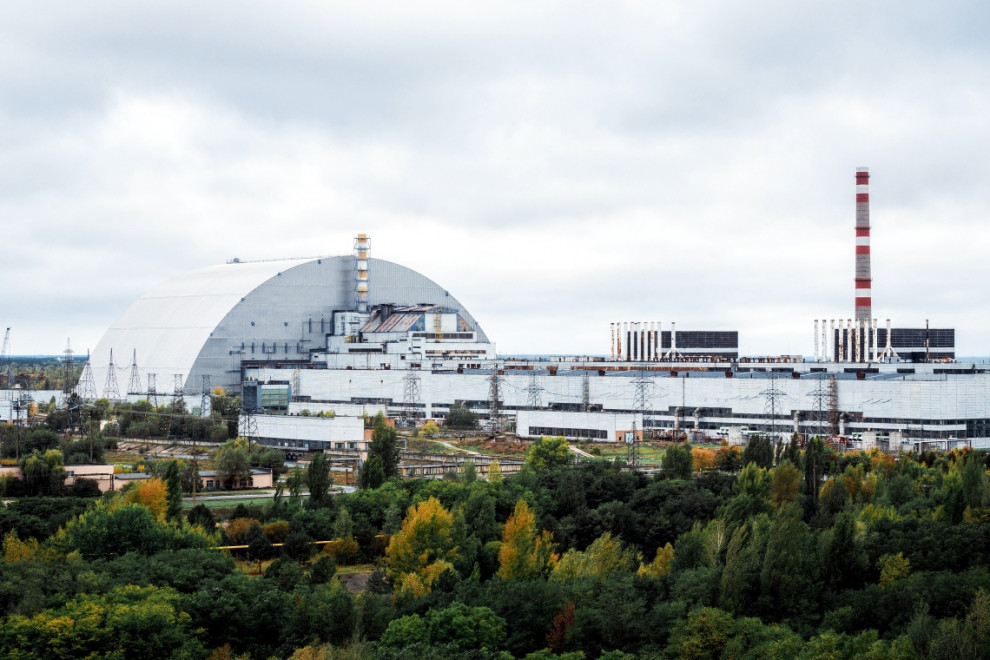In a ceremony attended by Ukraine’s President Volodymyr Zelenskyy on the site of the former Chernobyl nuclear power plant the keys for the New Safe Confinement shielding the destroyed reactor 4 were symbolically presented to the Ukrainian authorities today. This marked the next step in the transformation of Chernobyl into an environmentally safe and secure state.
The handover also represented the completion of the largest ever example of international cooperation in the field of nuclear safety. The event was attended by the President of Ukraine, Volodymyr Zelenskyy, the Chairman of the Chernobyl Shelter Fund, Hans Blix, the EBRD Managing Director for Ukraine, Eastern Europa and the Caucasus, Matteo Patrone, the EBRD Director for Nuclear Safety, Balthasar Lindauer, and donor representatives.
Mr Lindauer said: “We are proud and pleased to see the completion of the New Safe Confinement. I would like to congratulate Ukraine on reaching this milestone and I would like to take this opportunity to thank those who have made this happen: the donors’ community, the EBRD and its shareholders, the international and local companies that turned the plans into reality, our experts from the Project Management Unit and the workforce which delivered this unprecedented achievement.”
The New Safe Confinement cost €1.5 billion and was financed by 45 donor countries and institutions. It encloses the destroyed reactor 4, the unit destroyed by the 1986 nuclear accident at Chernobyl, and the provisional shelter built after the accident which still contains the molten core of the reactor and an estimated 200 tonnes of highly radioactive material.
The giant arch was constructed in two halves near the accident site from 2010 to 2016 and eventually slid over the damaged reactor. It is the largest moveable land-based structure ever built, with a span of 257m, a length of 162m, a height of 108m and a total weight of over 36,000 tonnes equipped with a crane system for future dismantling work.
The structure is the most prominent component of the €2.1 billion Shelter Implementation Plan which included the completion of crucial infrastructure and safety projects, among others the stabilisation of the old shelter and the creation of the necessary infrastructure needed for the work at the Chernobyl site.
The delivery of the Shelter Implementation Plan and the New Safe Confinement is financed through the EBRD-managed Chernobyl Shelter Fund, established in 1997 and funded by contributions from 45 countries, the European Commission and the EBRD:
Argentina, Australia, Austria, Azerbaijan, Belgium, Canada, China, Croatia, Czech Republic, Denmark, Estonia, European Union, Finland, France, Germany, Greece, Hungary, Iceland, India, Ireland, Israel, Italy, Japan, Kazakhstan, South Korea, Kuwait, Liechtenstein, Lithuania, Luxembourg, Netherlands, Norway, Poland, Portugal, Romania, Russia, Saudi Arabia, Slovak Republic, Slovenia, Spain, Sweden, Switzerland, Turkey, Ukraine, United Kingdom, USA, EBRD.
The EBRD is providing €715 million of its own resources to support Chernobyl projects including the New Safe Confinement.
The EBRD is the only international financial institution with expertise in nuclear decommissioning and offers more than 30 years of expertise in managing donor-funded projects for the decommissioning of Soviet-era nuclear facilities and equipment and environmental remediation.
Currently, the EBRD manages seven donor funds supporting nuclear safety and security in the Bank’s regions. 45 donor countries and institutions, including the G7 countries and the European Commission, have pledged more than €4 billion to these funds to date.
The decommissioning programmes also finance a wide range of energy efficiency and energy sector projects to help compensate for the loss of generating capacity.






